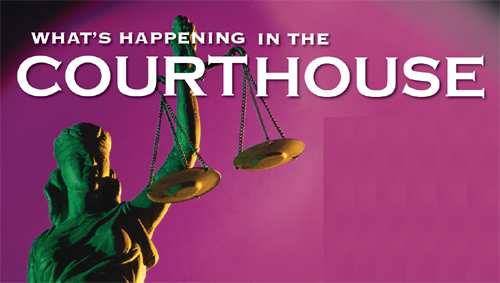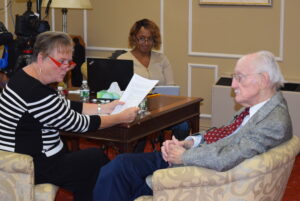Budget cuts in many states have led to increased concern about the continued place of court reporters in U.S. courts. The reality is far more varied.
It has been a challenging decade for state, local, and county official court reporters, to say the least. Not only have they been routinely targeted by judicial bureaucrats seeking cost savings by implementing recording technology, but they’ve also at times been swept up in the new privatization of government services trend, with courtrooms replacing officials — and their pensions and benefits — with independent reporters working on a per diem basis.
SO HOW IS THE OFFICIAL COURT REPORTING COMMUNITY HOLDING UP?
While that largely depends on not only who you ask, but where you go, for the most part, it can be characterized as not as good as it used to be, but not quite as bad as initially feared. In some states, such as Texas, there are even opportunities for young court reporters to embark on a career as an official provided they’re willing to start by working in a remote part of the state. Other states, such as Oregon, have no official reporters outside of the federal courts — and despite at least one high profile case involving a problematic digital audio recording of the penalty phase of a capital murder trial, there’s very little chance of reporters being put back on the payroll full-time any time soon. [Ed. note: There is a bill pending in Oregon that would require a court reporter on capital cases.]
It’s also interesting to note how the strategies employed by official reporters and the state court reporting associations that often go to bat on their behalf can vary dramatically from state to state. In California, for example, court reporters have largely succeeded in keeping out electronic recording, though independent reporters are now being brought in and paid for by the attorneys in civil cases in counties where some or all officials have been laid off. (See sidebar on page 40 for more about California’s changing landscape.) In contrast, in King County, Wash., the relatively successful focus of the unionized official reporters was on allowing electronic recording for some trials but keeping outside reporter from hearing cases.
And in Florida, the battle to keep out digital has resulted in a compromise of sorts: a mixture of digital audio, officials, and contract independents from local firms who work per diem, all of which is determined by the chief judge in each circuit. “The pendulum has swung and the courts have reached their own water level in terms of reporting methods,” says Sandra Estevez, current president of the Florida Court Reporters Association. “The power of the purse dictates the needs of the courts and hybrid methods utilized.”
In some states, you can find a silver lining if you look hard enough. Even California has Fresno County where there are still plenty of officials on staff, even as other counties have laid off all the official court reporters and privatized trial work.
If there is any lesson to be gained from looking at official court reporters in different states, it’s the notion of geography playing a role in destiny. If you’re fortunate enough to work as an official in a state or county with court administrators who value the integrity of the record over real or supposed budget savings, you have some job security. If not, then it doesn’t matter if you’re the most professional and skilled reporter in any courtroom — your job will likely be affected at some point, if it hasn’t been already.
Because of those disparities, this article is not meant to be an all-encompassing overview of how officials are faring. Rather, it’s a snapshot of sorts of what’s happening in various parts of the country and how officials reporters are either adjusting or battling the changes that are being proposed to their jobs.
With that caveat in place, here’s a look at the good, the not-so-good, and the somewhere in-between for officials across the country.
TEXAS OFFERS OPPORTUNITIES
There were numerous states that declined the opportunity to participate in this story, with several suggesting these were far too sensitive times to talk about this issue publicly. But of the ones that did, you would be hard to find a place better to be an official court reporter these days than Texas.
While there had been a bit of chatter about electronic recording or reducing the number of officials in Texas in the past, none of it was serious and none has been that recent, says Glyn Poage, RDR, CRR, an official court reporter in Texas’s 166th District Court in Bexar County in the San Antonio area and NCRA Vice President.
“We really haven’t had to fight back because it hasn’t really happened that much,” Poage says. “The reason official reporters have done so well in Texas is that we have the support of our legislature and of the Supreme Court of Texas. It’s been a real team effort centered on protecting the record and protecting the rights of everyone involved in the legal system.”
Poage explained that the court reporters in Texas are all employed by counties that handle statutory as well as district court trials and hearings. “Each reporter is assigned to a particular judge. But if that judge is not in court for a reason, the court reporter will be assigned to another courtroom for that day,” he says, and adds that unlike other states, younger reporters can still aspire to become state officials, provided they’re willing to venture to the state’s more rural areas and work for a judge who’s covering three or four counties.
Because of their success in keeping official court reporters in the state’s courtrooms, Poage said he is occasionally asked by colleagues in other states for advice, and he has to concede there’s no secret strategy to Texas’s success.
“Some of it has to do with the fact that so many of our legislators are actual trial attorneys, and they don’t want have to track down a transcript from someone who’s not in the courthouse,” Poage says. “Also, our official reporters really do stress dependability and professionalism — Texas is a CSR state and the Supreme Court of Texas oversees the test and the certification.”
“It comes down to the fiscal responsibilities of those in charge. Court reporters really don’t make money decisions; we just do our job. In Texas, the legislature and the others who make funding decisions — and keep in mind that Texas is a growing state with a good economy — have handled it very well and been able to provide services for the residents of our state. It’s them, and it’s not us,” Poage says.
OREGON’S MIXED BAG
When electronic recording companies began making their cost saving pitch across the country in the 1990s and early 2000s, Oregon was one of the states that bought into it hook, line, and sinker. The state courts laid off most of the state’s official court reporters and installed electronic recording systems from For the Record, known by many as FTR. The clerks in the courtroom were given the additional duty of monitoring that equipment, making the recording, and labeling them and storing them.
There are still official reporters in Oregon’s federal courthouses, says Robin Nodland, RDR, CRR, of LNS Court Reporting and Videoconferencing, based in Portland, Ore. And not every case in Oregon is electronically recorded.
“If a particular litigant wants a reporter in the courtroom, they can hire them privately,” Nodland says. “So in reality, it’s been a cost shifting and not a cost savings.” She adds that in some civil cases, opposing counsels agree to split the cost for a reporter.
“When we go into a courtroom, there’s a form that we need to get all the parties to sign that stipulates that we are the official record — otherwise it’s the digital recording that is the official record. The other requirement is that you must be a certified shorthand reporter, which is our state designation, or a registered professional reporter, which is the NCRA certification, or higher.”
The removal of officials has provided a modest boost to court reporting firms in Oregon as they can now count on some trial work as part of their day-to-day business. “A lot of firms have reporters who used to do trial work as officials,” Nodland says. “They love trial work, and they love going back there and handling it. But it’s not a full-time job for any reporter.”
What’s stunning about Oregon is how quickly they got rid of their official court reporters, not just for run-of-the-mill traffic and misdemeanor cases, but for everything, including aggravated murder cases where the death penalty in a possibility. One high-profile Oregon murder case — that of Randy Guzek, convicted and sentenced to death for a 1987 double murder — led to decades of appeals centered on whether new evidence can be provided during the sentencing phase of a trial. Some of those appeals were in courtrooms where digital audio was used and the quality of those recordings was so poor, it triggered calls from the Oregon’s leading newspapers, the Oregonian, to bring back court reporters at the very least for capital murder trials. There is a bill currently before the Oregon Senate to require just that, but at our deadline, the bill’s fate remained uncertain.
MIDDLE GROUND
For most states, the situation for officials is far less draconian. Many still have official reporters, just not nearly at the numbers they were several years ago. New Jersey is a good example of this. “When I left my position as an official court reporter in 1996, there were 210 officials in New Jersey. Now we’re down to fewer than 40,” says Robert Boccolini, RPR, current president of the New Jersey Certified Court Reporters Association.
This decline in numbers has been slow but steady, and Boccolini says that it’s all attrition rather than lay-offs. “The state did have a plan a few years back to hire a few reporters who were either realtime certified or planning to become realtime in the next two years,” he says. “But that ended up adding fewer than 10 — and since then people who have retired have not been replaced.”
Virtually all of the remaining New Jersey officials are providing realtime for their judges, including one Newark reporter whose judge is hearing impaired. “If not for realtime, we would be gone,” Boccolini says. “It saved the jobs that are still there by making them more valuable.”
But because of their reduced numbers, New Jersey official reporters, all of whom are employed by the state rather than individual counties, tend to focus on only criminal cases, save for special circumstances such as highly complex civil trials with multiple litigants on both sides.
But as Boccolini says, “How can somebody make a decision that somebody’s civil case is less important than a criminal case. True, you could argue you’re not just going to lose your money [in a criminal case], you’re going to lose your liberty. But if you’re a plaintiff in a civil case, and you’ve got catastrophic injuries due to negligence in traffic accident, who says one trial isn’t as important as another?”
It was exactly that kind of issue that prompted the official court reporters in King County, Wash., to go to management to work out a method to prioritize criminal and civil cases, starting at the top on the criminal side with murder, serious assault, and rape, and then to cases involving young children because digital audio can’t often pick up their quiet voices. The priority then shifts to complex civil litigation that involve multiple attorneys asking for services such as daily transcripts, because it’s a lot harder to get transcripts from electronic recordings in an expedited fashion.
“In King County, it used to be a one-on-one: every judge had a court reporter. There were 39 reporters here about 10 years ago,” explained Michelle Vitrano, RDR, CRR, CPC, an official with King County for the past 23 years. “And then the budget started getting bad, and they installed more FTR. Now we have 11 reporters in downtown Seattle and four in our regional courthouse in Kent, so 15 total reporters for 55 judges.”
Vitrano says that when there is no court reporter available, the judge has to turn to electronic recording. “We’re unionized and we have fought very hard not to allow outside reporters into our courtrooms,” she says. “But we are losing two people this year, and it’s getting very busy. We’re running from court to court, and we’re all providing realtime. So it’s crazy around here, but we are still employed.”
Other counties — all official reporters in Washington state are employed by the county and not the state — seem to doing as well if not better than King County. Vitrano suggests the worst may be over, saying: “They’ve pretty well got all the cost savings they can out of us.”
For other states, success is measured by how close they’ve been able to maintain the status quo.
In Tennessee, for instance, officials organized quickly to beat back an attempt by the state Administrative Office of the Courts in 2010 to first replace staff official reporters with contract reporters hired on a per diem basis and then eventually replace those workers with contract workers who would monitor electronic recordings.
“The officials gathered as much information and documentation as possible, in the limited time we had to work with, regarding outcomes in other states that had eliminated officials in the past and presented it to our judges,” says one official who requested anonymity. “The judges were extremely supportive of the official reporters and resisted this attempt by the AOC to eliminate reporters from the criminal courts. We were eventually notified that there would not be any further cuts at that time. Personally, I think they were surprised by the strong resistance they encountered from the judges.”
Even with that victory, fewer than 30 official court reporters remain employed by the state and none work in civil court. If attorneys want something other than a digital audio recording, they have to hire a reporter privately to come in for that trial or hearing. But for now at least there are no plans to eliminate any more official positions, the source adds, “I think our judges are the reason Tennessee still has court reporters in the courts today.”
Some states are seeing a change even now. In 2009, due to budgetary issues, many Iowa state court employees, including reporters, were laid off due to budget constraints. As of July 1, however, Iowa has been advertising that it wants to fill 12 court reporter positions across the state. “Iowa reporters have worked hard at being team players within the judicial branch. Our Supreme Court officials, as well as many district associate, and juvenile judges, and the state bar, support and value steno reporters. The addition of 12 new positions is proof of that,” says Sarah Hyatt, RPR, of Cedar Rapids, Iowa, current president of the Iowa Court Reporters Association. “And when Iowa’s budget was finally able to more fully fund the courts, we were thrilled that the decision was made to hire additional qualified reporters.”
California and the wild west of court systemsCalifornia may no longer be the Wild West, but you wouldn’t know by looking at the state’s court system and both how and when transcripts and the official record are being created there. Thanks to a concerted lobbying and legal effort led by groups such as the California Court Reporters Association, there is very little electronic recording in California county courts, and most of the ER is used for misdemeanors and traffic hearings. But the success in keeping digital audio out hasn’t prevented some county governments in the state from laying off some — or in the case of Placer County, all — of its official court reporters. The result right now is that California has a little bit of everything. Placer County, for instance, has outsourced all its trial work to a single private court reporting firm after a bidding process. Los Angeles County, like other California counties, has laid off a portion of its official reporters, largely in civil courts, forcing attorneys who want a record and a transcript to hire a private court reporter. “Officials are definitely out in some counties,” says Kristi Garcia, a Fresno County official court reporter and current CCRA president. “Not in all counties but in some counties, they’ve taken reporters out of family law courts. But independent reporters can go in there, so that’s a win for court reporters. We’re just glad there’s a court reporter in the courtroom and not electronic recording.” The reason for that victory was a lawsuit against California’s Administrative Office of the Courts for putting in electronic recording in courtrooms when it didn’t have the funding to do so from the state legislature, a case that went all the way to the California Supreme Court. Garcia notes that in misdemeanor courts, there is some electronic recording, but all felonies still must be reported by a court reporter. “For civil trials, they all bring in their own,” she says, adding that for probate and for family law, there may not be either digital audio or a live court reporter. “Sometimes there’s no record at all because there is no reporter and they’re not recording. So when you’re fighting for your kid in family court, there’s going to be no record.” The lack of certainty about whether a trial will have a record is triggering some angst in the state’s legal community, says Sandy Bunch VanderPol, RMR, CRR, an independent reporter in Lotus, Calif. “A lot of the attorneys are getting frustrated because they would rather have something in there, but they don’t want to pay to have a court reporter,” says VanderPol. But for VanderPol, whose resume includes stints as CCRA president as well as being both a firm owner and independent reporter, all these changes in how trials are reported recently gave her the opportunity to do something once considered rare for a private independent reporter: She handled a case for a client from start to finish, beginning with the depositions and running all the way through the trial. She’s not alone. “I have a very good client base for depositions and that’s what I would prefer to do, but there are a lot of reporters that are now doing trials along with depositions,” VanderPol says. While no one will admit it for attribution, the presence of independent reporters in trials doing a job that used be handled by an official has, on occasion, generated some tension, though not recently. “When the client of the depo reporter asks them to come in and do the trial, and the officials that were in that courthouse see that, they’ve became upset, so it was a big deal,” says one reporter who requested anonymity to speak freely about this topic. “Now everyone can see the big picture and realize they shouldn’t be mad at their own profession; we should be mad at the people laying us off.” Notably, the layoffs that have impacted California officials hasn’t really changed the demand for good trial reporting. “It’s not that there’s less need for reporters in courtrooms,” VanderPol says. “It’s just that we’re doing our jobs differently because now you have to get hired by a litigant rather than being on salary by the court.” But it is starting to create some downward price pressure as exofficials compete with both firms and independent reporters for trial work. “These days you’ve got to cut a lot of deals to get any business,” says one source. The other big change is that ex-official reporters are now beginning to think and act like small businesspeople rather than California government employees. |





















